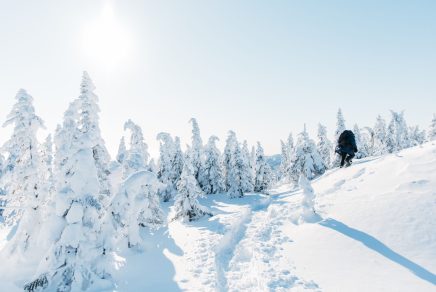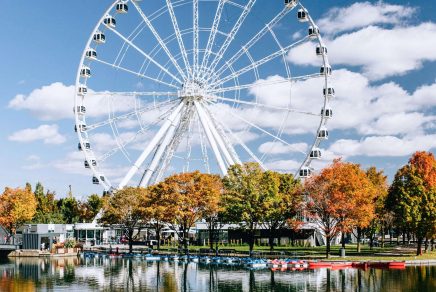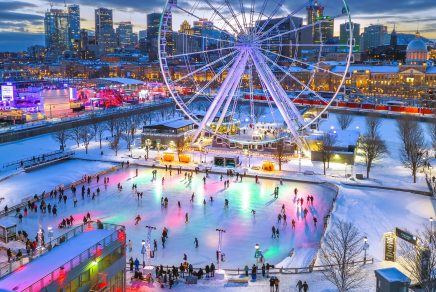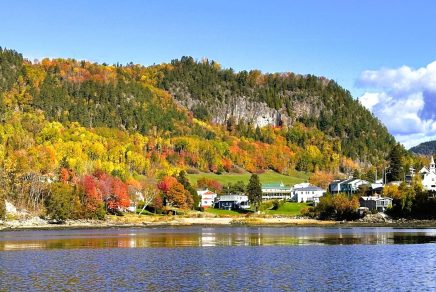Share the article
At one end lies Canada’s youngest province Newfoundland and Labrador, at the other, farther north, there’s the Yukon, the territory that gave us the gold rush . While they may be geographically opposed, these two corners of the country are both outdoor playgrounds saturated with intriguing history.
The East Coast rush
There are some strange signs on the road to L’Anse aux Meadows, in western Newfoundland, like the one that shows a moose crushing the hood of a car. My guide Doug bursts out laughing at my look of confusion. “It’s really dangerous to drive out here at night,” he says. “A moose can run out into the road at any time.” Welcome to Newfoundland and Labrador, where 528,448 humans and approximately 120,000 moose share 405,212 square kilometers of land, which is just a bit smaller than France. And in this postcard come-to-life, there’s no point trying to count all the bears, caribou and rabbits that live here.
After exploring the fascinating Tablelands in Gros Morne National Park, which witnessed the moment the continents of Europe and North America collided with each other, the road that leads to L’Anse aux Meadows feels like it leads to the ends of the Earth. This is how the Vikings must have felt when they landed on the northernmost tip of the island around 1,000 years ago. When Leif Eriksson stepped onto the soil of this land, where wild grapes grew in abundance, he decided to call it Vinland. It would be another 500 years before Christopher Columbus “discovered” the very same continent.
Watching the landscape roll by, I can’t help but think that, while this country is only 150 years old, its “prehistory” gives it a profound richness. A visit to the historic site of L’Anse aux Meadows allows visitors a glimpse of the oldest evidence of European activity in the Americas, the place where those Scandinavian sailors from Greenland built a small encampment made of wood and sod. Guides dressed like Vikings relive the era through re-enactments and artifacts. The wind blows endlessly through the scrub, cliffs rise dramatically out of the sea, and peat bogs dot the landscape where Eriksson and his people fished and lived.
The next morning, in St. Anthony, I see my first icebergs and taste a piece of ice that has washed up onto the pebble beach. Restaurants in the area serve up some pretty cool drinks, which feature iceberg shards instead of traditional ice cubes. Iceberg Beer, one of the beers produced by the Quidi Vidi Brewery, is made with water drawn from icebergs off the coast of Newfoundland. As you might imagine, their lager made with 25,000-year-old water is one of the province’s top five beers, according to the Newfoundland Labrador Liquor Corporation
West of eden
You never know who you might run into at the Westminster Hotel, nicknamed The Pit, in Dawson City, Yukon. “Caveman Bill”, so named because he lives in a cave on the other side of the river,sometimes drops in. You might well spot a gold miner who has made a fortune, or a criminal on the lam. “We don’t ask people who they used to be,” confides Quebec author Mylène Gilbert-Dumas, who has based many of her novels in the Yukon, including her bestseller, Yukonnaise. Indeed, Dawson was once known as the Paris of the North, due to the mystery that surrounded so many of its inhabitants. Just about everyone you meet in this remote territory is like a character from a novel.
One of the Yukon’s most flamboyant characters is Captain Dick, who greets tourists wishing to join the exclusive Sourtoe Cocktail Club. Membership requires swallowing a glass of alcohol in which a mummified toe has been soaked.
There’s a rather peculiar attraction a few streets away: half of writer Jack London’s house. His work being intimately associated with the Klondike, there’s a little museum dedicated to him beside the part of his house that remains in Dawson; the other part was transported to Oakland, Calif., the White Fang author’s hometown.
The Yukon Quest is a prestigious 1,600-kilometre dogsled race with participants and spectators from around the world. The course follows in the footsteps of the gold prospectors and letter carriers of the last century, passing through Fairbanks, Alaska, and ending in Whitehorse.
Ever wonder what a gold rush miner’s life was like? Justin Millar regales tourists with the story of how his father made—and lost—his fortune, and shows us how to prospect for gold. Holding our pans, we follow him into the river in the hopes of finding a nugget of gold for ourselves. In historic Dawson City, where everything reminds us of the gold miners who passed through here, tourist guides enthusiastically bring the miners’ ghosts to life and take us on a tour of the city’s key sites, like the bank where some prospectors earned their living sweeping up the gold dust on the floor. In the midnight light of the summer solstice, you can almost see the silhouettes of all those hopeful people who came to this city to seek their fortune.
The Yukon is, above all, a natural wonder. Did you know that the territory contains one of the world’s largest ice patches outside the poles, as well as the world’s smallest desert (2.6 square kilometres)? It is also home to some of North America’s rarest animals, a place where caribou, wolves and grizzlies cross paths with lynx, foxes and migratory birds. Given its northern setting, the aurora borealis makes frequent appearances. In the fall and spring, when the days are shorter, warm yourself by a campfire, or settle into one of the cabins set up for the purpose, and watch the show. There are also guides with dogsleds willing to take tourists to whichever spot they choose to see the northern lights.
Will you fly over the glaciers of Kluane National Park and Reserve, close to Mount Logan, Canada’s highest mountain? Go rafting through the valleys of Ivvavik National Park? Or hike the historic Chilkoot Trail? No matter what you choose, one thing is certain: with wilderness making up close to 80 per cent of the Yukon’s landscape, you’ll experience nature in all its glory, whatever the season. And chances are, you’ll vow to return.






